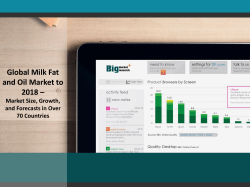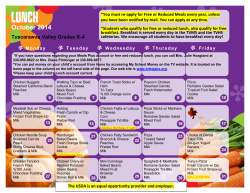
Storage & Handling of Breastmilk
Information for breastfeeding military mothers STORAGE, HANDLING & USAGE OF BREASTMILK It is important, as a military mother who is pumping breastmilk for your baby, that you store your milk in the cleanest and safest way possible. There are a variety of storage containers available, choose what works best for your situation. Follow the guidelines below for best practices regarding temperatures and times when storing your expressed breastmilk: Cleanliness • Wash hands with soap & water or hand cleanser before expressing your milk • No need to sterilize containers. Use hot, soapy water, or a dishwasher. Use boiling water if soap is not available. Containers • Bottles -‐ Glass or plastic, protect your milk, and are a one-‐time expense. However, they are bulky and can take up a lot of room to store. There is less fat, immunoglobulin A and white blood cell loss with glass or plastic bottles. Look for BPA-‐free bottles. Do not use steel bottles. Bottles should have well-‐fitting, airtight, solid tops. • Bags -‐ Plastic (polyethylene) milk storage bags, made for freezing and storing human milk, are convenient and take up less room for storage. They are a one-‐time use ONLY product and cannot be reused. They are expensive. They can be attached directly to the breast pump. Moving the milk between bag and bottle for feeding increases spillage and contamination. Feeding sized quantities Store expressed breastmilk in ‘feeding sized’ quantities (two to four ounces) to minimize waste and make thawing easier. Some mothers use an ice-‐cube tray or MilkTrays® to freeze their milk. Filling Do not fill either hard-‐sided containers or milk storage bags more than three-‐fourths full to allow the milk to expand as it freezes. If you express into bottles, leave the cap loose before freezing, and then tighten once the milk is frozen. Squeeze out the air in milk storage bags before sealing. This also helps to prevent freezer burn and your milk from absorbing the odors from other foods. Layering Breastmilk It is fine to “layer” or combine milk from different pumping sessions on the same day. Chill the “new” milk for at least 30 minutes before adding to already frozen milk. Date from the oldest layer. Labeling Label each container of milk with the date of expression and your baby’s name, using a sticky label or non-‐toxic marker. Labeling ensures that your baby gets your milk at childcare. Storage solutions Many mothers find a rack (for bottles), a plastic container, soda can boxes or gallon-‐ size freezer bags (for bags) to be helpful. Make sure to mark the larger container with the month and year of milk collection. Milk Usage Guidelines Your freshly expressed breastmilk should be given to your baby as soon as possible to have the maximum benefit. The vitamin content of expressed breastmilk degrades and the bacteria count increases the longer it is stored. Breastmilk is full of immune properties that help to prevent bacteria from multiplying. Refrigeration of breastmilk preserves most of the immune properties, but not all of them. Freezing destroys the white blood cells that protect against illness, but preserves other immune properties. Room Temperature Freshly expressed breastmilk can be kept at room temperature for 4-‐6 hours at temperatures up to 77°F or 25°C. If it will need to stay out longer than that refrigerate it. Milk that was previously refrigerated should not stay out at room temperature for more than an hour. Insulated Cooler Freshly expressed milk can be kept cool in an insulated container with freezer gel packs or ice packs when no refrigeration is available for up to 24 hours at 59°F or 15°C. Refrigerated Freshly expressed milk can be refrigerated for 3-‐8 days at 39°F or 4°C. Always place your expressed milk in the coldest part of the refrigerator, usually at the back, away from the door. If your milk is nearing the end of a week in the refrigerator, move it up to the freezer. *Human milk is NOT a body fluid that requires special handling or storage in a separate refrigerator as a bio-‐hazardous material. It can be stored in a common refrigerator at work and childcare facilities. (~Centers for Disease Control and the Occupational Safety and Health Administration) Frozen Frozen breastmilk will remain safe to use for 3-‐6 months in a self-‐contained refrigerator/freezer unit. You can store your milk in a deep freezer for 6-‐12 months at -‐4°F or -‐20°C. Place containers of breastmilk at least an inch away from the walls of a self-‐ defrosting freezer to prevent defrosting and refreezing. Do not store containers in the door of a freezer where the temperature fluctuates. Plastic storage bags should be double-‐bagged or protected in a larger container to prevent tearing. Thawing Breastmilk Thaw overnight in the refrigerator if possible. Thaw in a pan of warm water or under running water if time is short. Never use a microwave to thaw or warm breastmilk. Thawed breastmilk needs to be discarded after 24 hours. Discard breastmilk left in a bottle after feeding. Do not refreeze breastmilk. Transporting Chill the milk that you pump at work in the pump cooler bag or refrigerator first. Then transport home in the cooler bag. Dry ice can be used for long distance transportation. Use gloves when handling dry ice. Adequate ventilation is required when using dry ice in a vehicle. Put the expressed breastmilk into the refrigerator or freezer as soon as possible once you are at your destination. © 2010-‐2015 Robyn Roche-‐Paull, RN, BSN, IBCLC www.breastfeedingincombatboots.com The information contained in this handout is solely for general education and informational purposes only. Always seek the advice of your health care provider for any questions you may have regarding your o r your infant‘s medical condition.
© Copyright 2025










